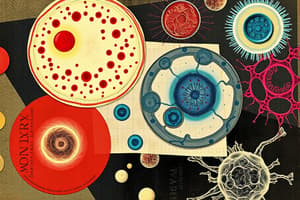Podcast
Questions and Answers
How are cells classified?
How are cells classified?
- Based on their color
- By their function and shape (correct)
- By their size only
- Prokaryotes and eukaryotes (correct)
Prokaryotes have a nucleus.
Prokaryotes have a nucleus.
False (B)
What type of cells are prokaryotes?
What type of cells are prokaryotes?
Simple, primitive cells without a nucleus
What is a eukaryote?
What is a eukaryote?
Which of the following statements are true about prokaryotes? (Select all that apply)
Which of the following statements are true about prokaryotes? (Select all that apply)
What are some similarities between eukaryotes and prokaryotes? (Select all that apply)
What are some similarities between eukaryotes and prokaryotes? (Select all that apply)
Flashcards are hidden until you start studying
Study Notes
Cell Classification
- Cells are classified based on their function, which influences their shape.
- Two main categories: prokaryotes and eukaryotes.
Prokaryotes
- Simple, primitive cells that lack a nucleus and membrane-bound organelles.
- DNA exists freely in the cytoplasm.
- Exclusively represented by bacteria.
- Known for rapid reproduction.
- Represented as the earliest type of cell on Earth.
Eukaryotes
- Defined as "true cells" that possess a nucleus and membrane-bound organelles.
- DNA is contained within the nucleus.
- Includes all other living organisms beyond bacteria.
- Generally larger and reproduce at a slower rate than prokaryotes.
- Eukaryotes appeared later in the evolutionary timeline.
Similarities between Eukaryotes and Prokaryotes
- Both classifications are types of cells.
- Each contains DNA as genetic material.
- Both types have cytoplasm supporting cellular functions.
- Ribosomes are present in both, functioning in protein synthesis.
Studying That Suits You
Use AI to generate personalized quizzes and flashcards to suit your learning preferences.



